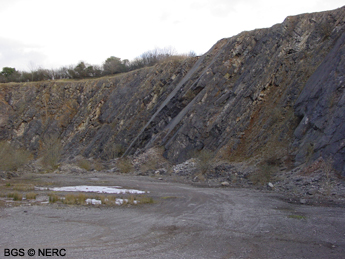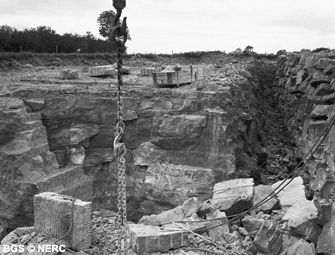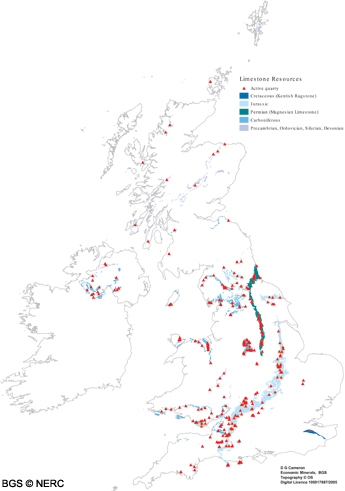
Quarrying
Stone as a resource
Uses of stone | Aggregate resources | Stone production
Aggregate resources

South-east of a line from Portland Bill to Flamborough Head, there are no significant areas of reasonably hard rock outcrop in England. In this area, sand and gravel are the only local source of aggregate, but although they can often make good concrete, are not generally as versatile as rock. However, south-east England has the highest demand for quality aggregate, not only because it is one of the most densely populated part of Britain, but also because it contains fast growing areas around the Thames estuary, Ashford, Milton Keynes and Cambridge.
By far the largest areas of hard rock are the Carboniferous Limestone outcrops of Mendip and the Bristol region. The darker, less pure Carboniferous limestones, such as the Black Rock Limestone with 6 to 7% silica, are best suited for use as aggregates. In contrast, some of the lighter oolitic limestones, such as the Burrington Oolite, are extremely chemically pure, with 99% calcium carbonate, and are used in the chemical and steel industries.
These Carboniferous limestones make up the majority of the Mendip Hills. Today, aggregate extraction is concentrated at the eastern end of Mendips in part because this is closest to the large markets of south-east England. In addition, the quarries can also be readily hidden in the low 'plateau' topography, and avoid both the highly valued landscapes and water supply areas to the west. For this reason, two of the largest limestone quarries in Europe are located here. Smaller quarries occur further west around Cheddar, but these supply mostly local markets.

Other hard rocks occur, particularly the Silurian andesite lavas around Beacon Hill. These have similar properties to some Leicestershire igneous rocks and can be used for skid-resistant road surfacing. However, their outcrop is restricted to a small area at Moon's Hill, Stoke St Michael. The Devonian Portishead Formation is generally too friable and inconsistent to be used as aggregates. The younger Jurassic limestones are highly variable in terms of chemical and physical quality and usually occur as very thin beds, interleaved with sandy or clayey material and as such are not well suited to modern quarrying or aggregate and industrial requirements. However when worked selectively in certain areas, the limestones of the Inferior Oolite (Middle Jurassic), notably at Doulting, are sufficiently consistent and attractive to have been used as a fine building or decorative stone.
- Home
- Overview maps
- Locality
areas
- Cheddar Gorge
- Charterhouse
- Blackdown
- Burrington Combe
- Shipham & Rowberrow
- Crook Peak & Axbridge
- Banwell to Churchill
- Priddy
- Harptree & Smitham Hill
- Draycott & Westbury-sub-Mendip
- Wookey Hole & Ebbor Gorge
- Wells
- Great Elm & Vallis Vale
- Mells & the Wadbury Valley
- The Vobster area
- The Whatley area
- Torr Works & Asham Wood
- Beacon Hill
- Stoke St Michael & Oakhill
- Holwell & Nunney
- Shepton Mallet & Maesbury
- Gurney Slade & Emborough
- The Nettlebridge valley
- Geology
- Minerals and mines
- Quarrying
- Caves and karst
- Biodiversity
- Detailed site information
- Acknowledgements
- External links
- Search
- Site map
